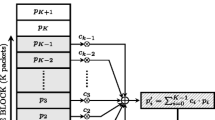Abstract
An intermittently connected network (ICN) is defined as a mobile network that uses cooperation between nodes to facilitate communication when a connected path between the source and destination does not exist. This cooperation consists of nodes carrying messages from other nodes to help deliver them to their destinations. An ICN does not require an infrastructure and routing information is not retained by the nodes. While this may be a useful environment for message dissemination, there are challenges in routing messages. In particular, providing satisfactory delivery performance while maintaining a low overhead ratio is difficult without routing information or a network infrastructure. In this paper, erasure coding is employed to improve the delivery rate in an ICN. The message delivery probability is derived and used to evaluate the performance. It is shown that the use of erasure coding can significantly improve the message delivery rate.








Similar content being viewed by others
References
Vahdat, A., & Becker, D. (2000). Epidemic routing for partially connected ad hoc networks. Duke University, Durham, NC, Technical Report CS-200006.
Spyropoulos, T., Psounis, K., & Raghavendra, C. (2005). Spray and wait: An efficient routing scheme for intermittently connected mobile networks. In Proceedings of ACM SIGCOMM workshop on delay tolerant networking, Philadelphia, PA (pp. 252–259).
Bista, B. B. (2016). Improving energy consumption of epidemic routing in delay tolerant networks. In 10th International conference on innovative mobile and Internet services in ubiquitous computing (pp. 278–283).
Li, L., Qin, Y., Zhong, X., & Chen, H. (2016). An incentive aware routing for selfish opportunistic networks: A game theoretic approach. In 8th International conference on wireless communications and signal processing (pp. 1–5).
Lindgren, A., Doria, A., & Schelen, O. (2003). Probabilistic routing in intermittently connected networks. ACM SIGMOBILE Mobile Computing and Communications Review, 7(3), 19–20.
Kang, M. W., & Chung, Y. W. (2016). An energy-efficient opportunistic routing protocol in delay tolerant networks. In International conference on information and communication technology convergence (pp. 655–659).
Bista, B. B., & Rawat, D. B. (2016). Enhancement of PRoPHET routing in Delay Tolerant Networks from an energy prospective. In IEEE Region 10 conference (pp. 1579–1582).
Altamimi, A. B., & Gulliver, T. A. (2012). A new routing protocol using mobile social network. International Journal of Wireless and Mobile Computing, 7(3), 1–11.
Huo, Y., Qi, J., Li, Z., & Jing, T. (2016). APPOW: An advanced routing protocol based on parameters optimization in the weighted mobile social network. China Communications, 13, 107–115.
Hui, P., & Crowcroft, J. (2007). How small LABELS create big improvements. In IEEE international conference on pervasive computing and communication workshops, White Plains, NY (pp. 65–70).
Costa, P., Mascolo, C., Musolesi, M., & Picco, G.-P. (2008). Socially-aware routing for publish-subscribe in delay-tolerant mobile ad hoc networks. IEEE Journal on Selected Areas in Communications, 26(5), 748–760.
Daly, E. M., & Haahr, M. (2007). Social network analysis for routing in disconnected delay-tolerant MANETs. In Proceedings of ACM international symposium on mobile ad hoc networking and computing, Montreal, QC (pp. 32–40).
Hui, P., Crowcroft, J., & Yoneki, E. (2008). Bubble rap: Social based forwarding in delay tolerant networks. In Proceedings of ACM international symposium on mobile ad hoc networking and computing, Hong Kong (pp. 1576–1589).
Bailey, N. T. J. (1975). The mathematical theory of infectious diseases (2nd ed.). London: Haffner Press/ MacMillan Pub.
Zou, C., Towsley, D., & Gong, W. (2006). On the performance of internet worm scanning strategies. Performance Evaluation, 63(7), 700–723.
Haas, Z. J., & Small, T. (2006). A new networking model for biological applications of ad hoc sensor networks. IEEE/ACM Transactions on Networking, 14(1), 27–40.
Groenevelta, R., Naina, P., & Koolec, G. (2005). The message delay in mobile ad hoc networks. Performance Evaluation, 62(1–4), 210–228.
Zhang, X., Neglia, G., Kurose, J., & Towsley, D. (2007). Performance modeling of epidemic routing. Computer Networks, 51(10), 2859–2891.
Bulut, E., Wang, Z., & Szymanski, B. (2010). Cost efficient erasure coding based routing in delay tolerant networks. In Proceedings of IEEE international conference on communications, Capetown (pp. 1–5).
Wang, Y., Jain, S., Martonosi, M., & Fall, K. (2005). Erasure-coding based routing for opportunistic networks. In Proceedings of ACM SIGCOMM workshop on delay-tolerant networking, Philadelphia, PA (pp. 229–236).
Liao, Y., Tan, K., Zhang, Z., & Gao, L. (2006). Estimation based erasure coding routing in delay tolerant networks. In International wireless communications and mobile computing conference on delay tolerant mobile networks symposium, Vancouver, BC (pp. 557–562).
Weatherspoon, H., & Kubiatowicz, J. D. (2002). Erasure coding vs. replication: A quantitative comparison. In Proceedings of international workshop on peer-to-peer systems, Cambridge, MA (pp. 328–338).
Pitkanen, M., Keranen, A., & Ott, J. (2008). Message fragmentation in opportunistic DTNs. In Proceedings of WoWMoM workshop on autonomic and opportunistic communications, Newport Beach, CA (pp. 1–7).
Keränen, A., Ott, J., & Kärkkäinen, T. (2009). The ONE simulator for DTN protocol evaluation. In Proceedings of international conference on simulation tools and techniques, Rome, Italy (pp. 1–10).
Author information
Authors and Affiliations
Corresponding author
Rights and permissions
About this article
Cite this article
Altamimi, A.B., Gulliver, T.A. On Erasure Coding in Intermittently Connected Networks. Wireless Pers Commun 97, 1579–1595 (2017). https://doi.org/10.1007/s11277-017-4587-3
Published:
Issue Date:
DOI: https://doi.org/10.1007/s11277-017-4587-3




